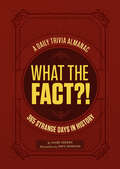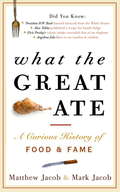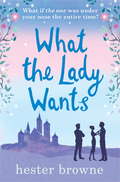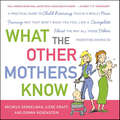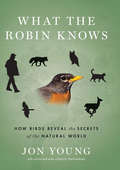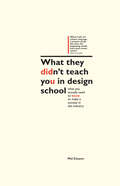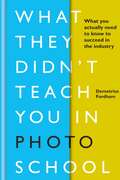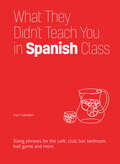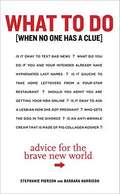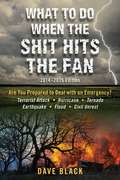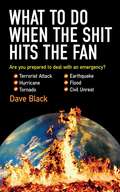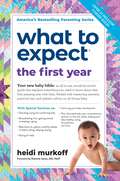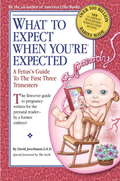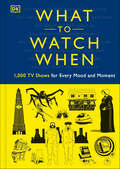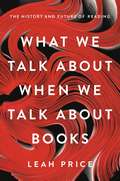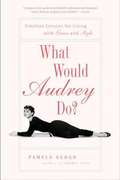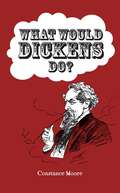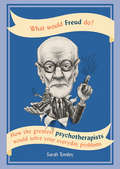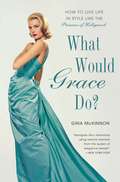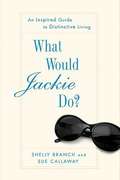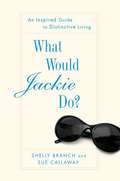- Table View
- List View
What the Fact?!: 365 Strange Days in History
by Gabe HenryEvery day is strange if you know your history.This illustrated daily trivia almanac explores a bizarre moment through the ages for each day of the year, such as:The odiferous debut of Smell-o-Vision (January 12, 1960)The execution of Oliver Cromwell, more than two years after his death (January 30, 1661)The day the first pig actually flew (November 4, 1909)That time the United States ran out of toilet paper (December 19, 1973)Drawing on a range of subjects including politics, sports, the arts, pop culture, and more, each What the . . . fact offers daily or dip-in-and-out diversion, and an opportunity to learn something new and stranger every day.
What the Great Ate: A Curious History of Food and Fame
by Matthew Jacob Mark JacobFor foodies and trivia lovers alike, this fun and impressively researched pop-culture history offers a sampling of the peculiar culinary habits of the famous--and often notorious--figures throughout the ages.
What the Lady Wants: escape with this sweet and funny romantic comedy (The Little Lady Agency)
by Hester Browne'A delicious, witty story. I loved it! SOPHIE KINSELLARunning The Little Lady Agency, Mel has one goal and one goal only: Make Men Better.But when her grandmother asks her to take on the case of a lifetime - Prince Nicolas of Hollenberg, Europe's most notorious of playboys - has she bitten off more than she can chew?Despite his good breeding, Nicolas is completely set on leading Melissa astray. Can Mel rise to the challenge? And has her own fairy-tale ending been there all along?'The most loveable romantic heroine since Jane Austen's Emma' Chris ManbyREADERS LOVE WHAT THE LADY WANTS'A must-read trilogy' *****'Couldn't put it down!' *****'Perfect for Jilly Cooper fans' *****'Such a fabulous, heart-warming set of books' *****'Fantastic' *****
What the Other Mothers Know: A Practical Guide to Child Rearing Told in a Really Nice, Funny Way That Won't Make You Feel Like a Complete Idiot the Way All Those Other Parenting Books Do
by Michele Gendelman Ilene Graff Donna RosensteinWritten by three mothers who've been through it all, What the Other Mothers Know gives you straight, funny, realistic talk on:getting drool stains out of clothing finding the perfect babysitter and maintaining her loyaltytaking car trips with toddlers recognizing how to set limits and holding to themsucking up to preschool directorskeeping your child off ihatemymom.comAnd much, much moreThe maternal wisdom of the ages is right in your hands—delivered with a heaping spoonful of humor.
What the Robin Knows
by Jon YoungCompanion audio files are available at www.hmhbooks.com/whattherobinknows A lifelong birder, tracker, and naturalist, Jon Young is guided in his work and teaching by three basic premises: the robin, junco, and other songbirds know everything important about their environment, be it backyard or forest; by tuning in to their vocalizations and behavior, we can acquire much of this wisdom for our own pleasure and benefit; and the birds' companion calls and warning alarms are just as important as their songs. Birds are the sentries--and our key to understanding the world beyond our front door. Unwitting humans create a zone of disturbance that scatters the wildlife. Respectful humans who heed the birds acquire an awareness that radically changes the dynamic. We are welcome in their habitat. The birds don't fly away. The larger animals don't race off. No longer hapless intruders, we now find, see, and engage the deer, the fox, the red-shouldered hawk--even the elusive, whispering wren. Deep bird language is an ancient discipline, perfected by Native peoples the world over. Finally, science is catching up. This groundbreaking book unites the indigenous knowledge, the latest research, and the author's own experience of four decades in the field to lead us toward a deeper connection to the animals and, in the end, a deeper connection to ourselves.
What They Didn't Teach You In Design School: What You Actually Need to Know to Make a Success in the Industry
by Phil CleaverYou'll appreciate this design career guide if:You're a recent graduate and looking for a job as a designer. You want resume and interviewing advice, as well as tips for working in the design industry. You'd like to learn how to avoid common pitfalls of asserting yourself in the design industry. <P><P>What They Didn't Teach You in Design School by Phil Cleaver provides advice on the stage from graduating, and getting into a studio and staying there as a valued designer, and explores best design practices. Though predominantly serving as a useful guide and bridge in the first year of your career as a designer, it should also be considered an essential tool that can be consulted when you're unsure of what to do next. Begin with the essentials of beginning your design career, like building your resume and portfolio, seeking out opportunities, and preparing for and securing interviews.More than just helping you get a job, however, this career guide serves to help you succeed in whichever design position you land. Learn how to effectively work with other designers and your own clients, keep up to date with the industry, hone your business skills, and much more. <P>From the day after graduation to the completion of your first year as a design professional, this career guide will help you stay on top of your game.In What They Didn't Teach You in Design School you'll find:11 chapters covering topics ranging from software skills, print production, and designer relations, to good design practice, web skills, and working with external suppliers. Helpful design advice that you'll want to return to again and againA word from the author:"Working in a studio is hugely different from studying; this book is aimed at helping you through the transition and giving you the ammo to climb this massive new learning curve." --Phil Cleaver
What They Didn't Teach You in German Class: Slang Phrases for the Café, Club, Bar, Bedroom, Ball Game and More (Dirty Everyday Slang)
by Daniel ChaffeyThe down and dirty phrases you need to speak German like a local—from tech speak to talking smack with fellow sports fans.Drinking a Hefeweizen at a Biergarten . . . Dancing at Berlin’s hottest club . . . Cheering for the local soccer team at the Stadion . . . Ditch the textbook dialogues and learn to really engage in meaningful (and sometimes meaningless) conversations with lifelong German speakers. From getting a date to hailing an Uber driver, you’ll learn helpful phrases and info to break down the language and cultural barrier. What’s up? Wie geht’s?He/She is a real hottie. Er/Sie ist eine ganz heiße Nummer.What’s on tap? Was gibt’s vom Fass?I ordered the Currywurst. Ich bin den Currywurst.Do you wanna cuddle? Willst Du kuscheln?Gooooooal! Toooooor!
What They Didn't Teach You in Photo School: What you actually need to know to succeed in the industry (What They Didn't Teach You In School #2)
by Demetrius FordhamThis book won't tell you how to take photographs. It will, though, teach you a much more difficult set of skills: how to be a photographer.Passing on hard-earned lessons from a successful career in commercial, editorial and lifestyle photography, Demetrius Fordham shows how to snag the best internships and assistant roles, impress at an interview, develop an amazing portfolio, forge strong relationships with clients, and lay the foundations of your own successful career. Illustrated throughout with Demetrius' own duotone photography, dramatically typeset to appeal to visual thinkers, and presented in an appealing handbook format, this is the book that will launch the careers of the next generation of photographers.
What They Didn't Teach You in Spanish Class: Slang Phrases for the Café, Club, Bar, Bedroom, Ball Game and More (Dirty Everyday Slang)
by Juan CaballeroLearn cool slang, funny insults and all the words you won’t find in a normal textbook in this guide to informal, conversational Spanish.You’ve taken Spanish lessons and learned all kinds of useful phrases. You know how to order dinner, get directions, and ask for the bathroom. But what happens when it’s time to drop the textbook formality? To really know a language, you need to know it’s bad words, too. You need this book.From common slang and insulting curses to explicit sexual expressions, this volume teaches the kind of Spanish heard every day across Latin America. Learn to sound like a native speaker with phrases like: • What’s up? ¿Qué tal?• What a hottie! ¡Que cuerazo!• Let’s pound these shots. Tráguemonos estos traguitos.• That ref sucks. Es una mierda ese árbitro/a.• I’m craving all-you-can-eat tacos. Me antoja un poco de taquiza libre.• Do you wanna hook up? ¿Quieres ligar?
What to Do When No One Has a Clue: Advice for the Brave New World
by Stephanie Pierson Barbara HarrisonIs it okay to text bad news? What do you do if you and your intended already have hyphenated last names? Is it gauche to take home leftovers from a four-star restaurant? Should you admit you are getting your MBA online? Is it okay to ask a lesbian how she got pregnant? Who gets the dog in the divorce? Is an anti-wrinkle cream that is made of pig collagen kosher? You will always have a clue with expert advice from: Badgley Mischka, designers Mark Badgley and James Mischka Rick Bayless, chef Colin Cowie, event producer Bethenny Frankel, author and star ofThe Real Housewives of New York City Arianna Huffington, editor in chief of The Huffington Post Daniel Jones, editor of theNew York Times“Modern Love” column Louis Licari, hairstylist Danny Meyer, restaurateur Marion Nestle, nutritionist Carley Roney, cofounder of TheKnot. com Paul Saffo, technology forecaster and futurist Pepper Schwartz, Ph. D. , sociologist and relationship expert Deborah Tannen, language expert Erik Torkells, editor for TripAdvisor. com Plus a dean of admissions, a leading dermatologist, a dog trainer, a founder of an online dating site, and other experts on what to do when no one has a clue.
What to Do When the Shit Hits the Fan: 2014-2015 Edition
by David BlackRecent events have taught us all that anyone, anywhere can face an emergency situation. Do you have the tools, equipment, and knowledge to ensure the safety of your family? With the expert advice in this handbook, you can be better prepared for any emergency: · Terrorist attack · Fire · Flood · Tornado · Winter storm · Hurricane · Landslide · Earthquake · Drought · Nuclear emergency · Civil unrest · And more In this updated edition, Dave Black addresses the full range of disaster that can turn an ordinary day into a fight for survival. He offers advice on alarms, insurance, preparing a "disaster kit," planning for evacuation, communication, emergency food handling, first aid, and more. With real-world considerations, he lays out the step-by-step responses that could save you and your family in a time of crisis.
What to Do When the Shit Hits the Fan
by David BlackWould you know how to prepare for an unforeseen emergency, or handle an unexpected disaster? With real-world considerations in mind, disaster preparedness consultant David Black shows us how to stay alive when tragedy strikes. His step-by-step actions can help us make it safely through a variety of crises, from catastrophic weather to terrorism to civil unrest. Black presents tailor-made plans for individuals, businesses, organizations, small groups, and communities to follow, in all regions of the country and broken down by type of emergency and environment. In addition, he provides a hierarchy for response including communication, healthcare, food, water, and shelter in the absence of institutions and commercially available services and supplies.
What to Expect the First Year: What To Expect When You're Expecting; What To Expect The First Year (What to Expect)
by Heidi Murkoff Sharon MazelSome things about babies, happily, will never change. They still arrive warm, cuddly, soft, and smelling impossibly sweet. But how moms and dads care for their brand-new bundles of baby joy has changed—and now, so has the new-baby bible. Announcing the completely revised third edition of What to Expect the First Year. <P><P>With over 10.5 million copies in print, First Year is the world’s best-selling, best-loved guide to the instructions that babies don’t come with, but should. And now, it’s better than ever. Every parent’s must-have/go-to is completely updated. Keeping the trademark month-by-month format that allows parents to take the potentially overwhelming first year one step at a time, First Year is easier-to-read, faster-to-flip-through, and new-family-friendlier than ever—packed with even more practical tips, realistic advice, and relatable, accessible information than before. Illustrations are new, too. Among the changes: Baby care fundamentals—crib and sleep safety, feeding, vitamin supplements—are revised to reflect the most recent guidelines. Breastfeeding gets more coverage, too, from getting started to keeping it going. Hot-button topics and trends are tackled: attachment parenting, sleep training, early potty learning (elimination communication), baby-led weaning, and green parenting (from cloth diapers to non-toxic furniture). An all-new chapter on buying for baby helps parents navigate through today’s dizzying gamut of baby products, nursery items, and gear. <P>Also new: tips on preparing homemade baby food, the latest recommendations on starting solids, research on the impact of screen time (TVs, tablets, apps, computers), and “For Parents” boxes that focus on mom’s and dad’s needs. Throughout, topics are organized more intuitively than ever, for the best user experience possible.
What To Expect the First Year, Second Edition
by Heidi Murkoff Arlene Eisenberg Sandee HathawayGives a month by month guide to your baby's first year.
What to Expect When You're Expected: A Fetus's Guide to the First Three Trimesters
by Mike Loew David JaverbaumThis new second edition is filled with the latest, most accurate wombhood information, including comforting answers to hundreds of questions.
What to Watch When
by Christian Blauvelt Laura Buller Andrew Frisicano Stacey Grant Mark Morris Drew Toal Eddie Robson Maggie Serota Matthew Turner Laurie UlsterAnswering the eternal question... WHAT TO WATCH NEXT? Looking for a box set to get your adrenaline racing or to escape to a different era? In need of a good laugh to lift your spirits? Hunting for a TV show that the whole family can watch together?If you're feeling indecisive about your next binge-watching session, we've done the hard work for you. Featuring 1,000 carefully curated reviews written by a panel of TV connoisseurs, What To Watch When offers up the best show suggestions for every mood and moment.
What We Talk About When We Talk About Books: The History and Future of Reading
by Leah PriceReports of the death of reading are greatly exaggeratedDo you worry that you've lost patience for anything longer than a tweet? If so, you're not alone. <P><P>Digital-age pundits warn that as our appetite for books dwindles, so too do the virtues in which printed, bound objects once trained us: the willpower to focus on a sustained argument, the curiosity to look beyond the day's news, the willingness to be alone. <P><P>The shelves of the world's great libraries, though, tell a more complicated story. <P><P> Examining the wear and tear on the books that they contain, English professor Leah Price finds scant evidence that a golden age of reading ever existed. From the dawn of mass literacy to the invention of the paperback, most readers already skimmed and multitasked. <P><P>Print-era doctors even forbade the very same silent absorption now recommended as a cure for electronic addictions. The evidence that books are dying proves even scarcer. <P><P>In encounters with librarians, booksellers and activists who are reinventing old ways of reading, Price offers fresh hope to bibliophiles and literature lovers alike.
What Would Audrey Do?: Timeless Lessons for Living with Grace and Style
by Pamela KeoghFrom the New York Times bestselling author of Audrey Style comes a charming guide to Audrey Hepburn?inspired living for the modern woman Audrey Hepburn epitomized grace and style, not only in her appearance but in her very essence. Whether in fashion, relationships, her work on the screen, or for UNICEF and her home life, there is no one more worthy of imitation. How did she do it? What Would Audrey Do? is the answer: a complete Audrey primer, with rich anecdotes and insight from the people who knew her best, and Audrey-inspired lessons in loveliness, including: · Dating advice from the woman who enjoyed romances with John F. Kennedy, William Holden, and Albert Finney · What made her an icon, and how to apply her style choices to twenty-first-century clothes, makeup, and accessories · Raising children, trying to raise husbands, and making home life balanced in every way · How to travel, what to pack, and maintaining your cool on the road · Using renown (long before Angelina and Bono got all the press) to help others around the world · Insight into her rich interior life and the discipline, intelligence, and generosity that made her so compelling In an era fraught with selfishness, flamboyance, and sensational headlines, Audrey as a role model is precisely what the world needs.
What Would Audrey Do?
by Pamela KeoghThe author of the bestselling Audrey Style and Jackie Style offers a charming guide to modern living inspired by the impeccable example set by Audrey Hepburn. Audrey Hepburn epitomised grace and style, not only in her appearance but in her very essence. Whether in fashion, relationships, home life, or her work - both on screen and for UNICEF - no role model is more worthy of imitation. So, who better to turn to when pondering the right thing to do in our complex, modern world? In an era fraught with self-interest, artifice and vulgarity, Audrey can teach us how to remain demure, sophisticated, loving and gorgeous, everyday. Drawing on examples from the actress's extraordinary life, this hugely enjoyable, beautifully-designed book offers advice on dating, seduction techniques and marriage from the woman who enjoyed romances with John F. Kennedy, William Holden and Albert Finney; tips on how to apply Audrey's style to twenty-first-century clothes, make-up and accessories; insights into raising children, taming husbands and achieving a work-life balance and lessons in philanthropy from the star who used her fame to help others long before Bono or Angelina. Indeed, everything one might need to survive in the modern world. So, in place of strife, just ask yourself: What would Audrey do?
What Would Dickens Do?
by Constance MooreTo celebrate the bicentenary of Charles Dickens’ birth, What Would Dickens Do? brings together the thoughts of some of his best-loved characters, as well as his own opinions. If you’re struggling with people’s great expectations or live in a bleak house, look inside for words of comfort and guidance from one of the world’s greatest writers.
What Would Dickens Do?
by Constance MooreTo celebrate the bicentenary of Charles Dickens’ birth, What Would Dickens Do? brings together the thoughts of some of his best-loved characters, as well as his own opinions. If you’re struggling with people’s great expectations or live in a bleak house, look inside for words of comfort and guidance from one of the world’s greatest writers.
What Would Freud Do?: How the greatest psychotherapists would solve your everyday problems
by Sarah TomleyWhat Would Freud Do? uses the key ideas of more than 80 psychological thinkers, past and present, to shine new light onto today's everyday problems. Ever wondered what a great therapist like Freud or Jung would have to say about your horrible boss, your phone-checking addiction or an occasional wish to cheat on your partner? Ever wished someone would explain why you sometimes act like an idiot just when you want to look good, or generally keep doing things you don't really want to do?From Erich Fromm on how to find Mr/Mrs Right, to Jaak Panksepp on road rage and Magda Arnold on how to deal with 'banter', these theorists have intriuging suggestions for ways to see and do things differently. Divided into five sections, including 'What am I like?', and 'Why am I acting like this?', other questions include:-'My family's a nightmare -- shall I cut them off?'-'Is my partner lying to me?'-'Why do I keep buying the same brand all the time?'-'How can I stop people unfriending me on social media?'-'Why do I lie when she says "Does my bum look big in this?"'With Sarah Tomley's enlightening commentary throughout, this book provides the answers to the most deep and meaningful (or, indeed, shallow and meaningless) questions that you have ever pondered. A pocket guide to facing the hurdles and obstacles of life, with the advice of all the greatest psychologists at your fingertips.
What Would Grace Do?
by Gina Mckinnon Penelope BeechFind your inner Grace: A modern day guide to the classic beauty and timeless style of the Hollywood starlet and real-life Princess, Grace Kelly Grace Kelly set a standard for elegance that continues to inspire women today--particularly in our Mad Men-crazed era. More than merely blessed with camera-wooing beauty, Princess Grace was also a canny decision maker who selected roles that quickly made her one of cinema's most adored and unforgettable leading ladies. She also captured hearts on- and off-camera, including many belonging to her handsome co-stars. Though her reign as Princess of Hollywood yielded all-too-soon to her real-life role as Princess of Monaco, Grace Kelly remains the timeless embodiment of refined glamour, style, and poise. Now, Gina McKinnon makes Grace Kelly's indelible style secrets available to everyone. In What Would Grace Do?, readers will find invaluable lessons in charm and loveliness--from handling careers and cashmere to manners and men. In the style of What Would Jackie Do? and What Would Audrey Do? comes a beautifully designed book filled with lovely two-color illustrations. What Would Grace Do? inspires women everywhere to reach for those moments of strife when we could all use a little Grace.
What Would Jackie Do?
by Shelly Branch Sue CallawayWe can't help but want to be like her: Exuding unmatched poise and style, she continues to fascinate people of all ages. But how would Jackie have handled the twenty-first-century? What would she think about a society that celebrates outsized egos, instant everything, and casual rules of conduct? How might she dress for the office, scan for a man, accessorize a home--and get away from it all when necessary? With intriguing research, commentary from today's experts, and fond reminiscences from those who knew and admired the first lady of perfection, journalists Shelly Branch and Sue Callaway now offer a sparkling answer to the question, What Would Jackie Do? Applying Jackie's philosophies to every aspect of contemporary life, including relationships, office politics, family matters, and entertaining, What Would Jackie Do? is a trove of advice, featuring: * Noblesse Oblige for Beginners * How Not to be an Interchangeable Woman * Mastering the Effortless Rich look * The art of attachment: lessons on sex, marriage, and men of consequence * Career Whirl: Pearls for Getting Ahead * Caftan in a Kelly bag: How to travel beautifully * O- Behave! Anti-brat strategies for parents * En Suite Home: Perfecting Your Domestic Pitch The next best thing to having Jackie O. as a personal adviser, What Would Jackie Do? reveals the practical wisdom behind an icon and gives all readers a piece of the Jackie mystique, be it of the heart, the mind, or the home.
What Would Jackie Do? An Inspired Guide to Distinctive Living
by Shelly Branch Sue CallawayFrom fashion to finance, a sophisticated and entertaining guide that shows readers how to attain the elegance and practical smarts that defined Jackie O. We can't help but want to be like her: Exuding unmatched poise and style, she continues to fascinate people of all ages. But how would Jackie have handled the twenty-first-century? What would she think about a society that celebrates out-sized egos, instant everything, and casual rules of conduct? How might she dress for the office, scan for a man, accessorize a home, and get away from it all when necessary? With intriguing research, commentary from today's experts, and fond reminiscences from those who knew and admired the first lady of perfection, journalists Shelly Branch and Sue Callaway now offer a sparkling answer to the question, What Would Jackie Do? Applying Jackie's philosophies to every aspect of contemporary life, including relationships, office politics, family matters, and entertaining, What Would Jackie Do?is a trove of advice, featuring: "Noblesse Oblige for Beginners" How Not to be an Interchangeable Woman -- Mastering the Effortless Rich look -- The art of attachment: lessons on sex, marriage, and men of consequence -- Career Whirl: Pearls for Getting Ahead -- Caftan in a Kelly bag: How to travel beautifully -- Behave! Anti-brat strategies for parents -- En Suite Home: Perfecting Your Domestic Pitch -- The next best thing to having Jackie O. as a personal adviser, What Would Jackie Do? reveals the practical wisdom behind an icon and gives all readers a piece of the Jackie mystique, be it of the heart, the mind, or the home.
